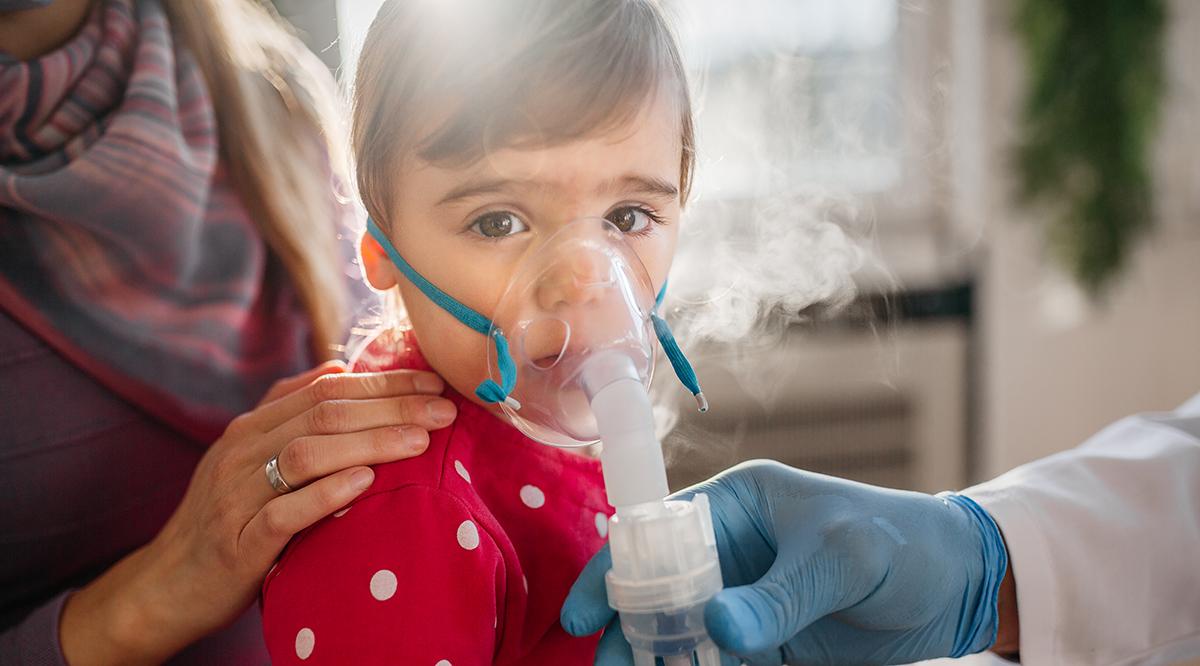As climate change pushes temperatures higher, wildfires have razed more than 6.1 million acres in the United States so far this year, outpacing the 10-year annual average of 5.2 million acres. And with smoke spreading throughout affected regions, millions of children are faced with the threat of poor air quality and the risks of both short- and long-term health consequences.
Air pollution can harm a person’s health at any age, but children are particularly vulnerable because their organs are still developing, says Ruth Etzel, MD, PhD, a pediatrician, expert on children’s environmental health, and the editor of Pediatric Environmental Health, a book published by the American Academy of Pediatrics (AAP).
“There are few organs that air pollution does not affect,” says Etzel, who is also adjunct faculty at the George Washington University Milken Institute School of Public Health in Washington, D.C.
And wildfires are far from the only source of poor air quality. More than 93% of children across the globe live in environments where air pollution levels exceed guidelines set by the World Health Organization (WHO), according to a 2018 WHO report. This can cause or exacerbate a range of health problems, from premature birth and neurodevelopmental damage to asthma and cardiovascular disease.
The AAP affirms the association between air pollution and many pediatric diseases and advises its members to educate parents and communities about prevention and mitigation, as well as to advocate for policy change that will improve air quality.
In its June 2021 policy statement, the AAP concluded that “ambient air pollution is increasingly recognized as a preventable risk factor for a spectrum of pediatric health concerns.”
And though air pollution has long been linked to adverse health impacts, Etzel says that emerging research has illuminated the need for urgent action to curb air pollution, mitigate its health effects, and educate communities and physicians on the associated risks.
“Many diseases are influenced by the environment,” she says. “We need to do a much better job of laying the foundation for this knowledge in the training of medical students.”
The impact of air pollution starts in the womb and lasts a lifetime
Pregnant people are often counseled to avoid certain foods, alcohol, and smoking to prevent negatively affecting the fetus’s development, but simply breathing in polluted air may cause harm.
Various studies over the past several decades have found an association between pollutants in the air and negative birth outcomes, including preterm birth, low birth weight, autism, asthma, and even stillbirth.
Researchers at New York University (NYU) Langone Health’s Division of Environmental Pediatrics studied data from the Environmental Protection Agency (EPA) for average air pollution exposure by U.S. county and compared it with Centers for Disease Control and Prevention (CDC) records of preterm births by county. They estimate that more than 3% of all premature births in the United States each year are caused by air pollution — accounting for about 16,000 premature infants annually.
According to that report, inhaled pollution can lead to toxic chemicals in the pregnant person’s blood, initiating immune distress that might weaken the placenta and result in early delivery.
“[Because] we had county level estimates of air pollution [we] could do a very refined estimate,” says Leonardo Trasande, MD, a pediatrician, professor at NYU Grossman School of Medicine and director of the Division of Environmental Pediatrics. “There were disproportionate effects in the South and Midwest.”
The researchers were looking at particulate matter measuring more than 2.5 microns in diameter (about 70 times smaller than the diameter of a single hair) but less than 10 microns in diameter. The matter can be made up of hundreds of chemicals released into the air from vehicle emissions, construction sites, fires, and unpaved roads.
It’s one of several types of air pollution that the EPA monitors and regulates, including ozone, which is formed when toxic chemicals (volatile organic compounds and nitrogen oxides) react in sunlight and heat; carbon monoxide, which is primarily emitted by cars, trucks, and other machinery that burn fossil fuels; and sulfur dioxide, which comes from power plants, industrial facilities, and heavy equipment like trains.
In the United States, the two most concerning pollutants for children’s health are particulate matter and ozone, Etzel says.
“Many pediatricians around the country believe current [EPA] air quality standards are not protective of children,” she adds.
Air quality and emergency department visits
As a pediatric pulmonologist practicing at the University of Pittsburgh Medical Center in Pennsylvania, Franziska Rosser, MD, MPH, decided to study why she was seeing so many children with acute asthma attacks. She looked at the relationship between the EPA’s daily Air Quality Index (AQI) in Allegheny County (which includes Pittsburgh) and the number of children presenting to the emergency department for asthma and found that even moderate levels of air pollution were associated with emergency visits. Black children and children between the ages of six and 11 were disproportionately affected.
“Air pollution is generally colorless and odorless,” Rosser says, explaining that her patients’ parents often can’t pinpoint what triggered their child’s asthma attack. She wanted to explore AQI data to be able to better counsel parents about how to avoid excessive exposure.
“Kids, in general, spend more time outside,” Rosser says. “Kids [also] breathe more air per body weight than adults.”
Rosser recommends that parents use the EPA’s website, AirNow.gov, or download its app, which offers real-time air quality by location, grading it from good (green) to hazardous (maroon). With this information, parents can plan to limit time outdoors or reduce more intense activities, such as running and playing sports, when pollutants are higher.
When air pollution is hazardous, for example, near a wildfire, people should stay inside and keep doors and windows closed to protect indoor air quality, according to the CDC.
And though wildfires have been a worsening threat, particularly in the American West, Rosser worries that places like Pittsburgh, which have moderate AQI more than half the year due to industrial sites, will see continued harm to children who are sensitive and can’t reasonably avoid being outdoors.
Rosser is hesitant to advise parents to keep their children inside for a moderate AQI rating when the impact of unintended consequences, such as loss of physical activity and effect on mental health, is unknown.
She recommends that if a parent or child notices their asthma is worse on a moderate AQI day, or a few days after, they should talk to their child’s asthma health care provider.
“The best thing that can be done is reduce air pollution,” she says. “It’s not fair to place the burden of air pollution on a child with asthma.”
Air quality and climate change
Air quality and climate change have a complex relationship, according to the EPA. Research shows that climate change can impact air quality, for example, warmer temperatures increasing ozone. Likewise, air quality can impact climate, such as black carbon (the soot produced by burning fossil fuels) warming the Earth.
One of the main drivers of climate change, the burning of fossil fuels, also impacts air quality.
“Everything is so interconnected; individuals and institutions should evaluate all of their activities and think about how much fossil fuels they’re using,” Etzel says. “Wildfires have now become the number one source of particulate matter in the U.S., which is dramatic.”
One 2021 study by researchers at Scripps Institute of Oceanography at the University of California, San Diego in La Jolla found that wildfires increased overall respiratory-related hospitalizations by 10% in Southern California.
“There’s absolutely a link between climate change and respiratory health,” Rosser says.
And while tackling climate change overall is a global task, studies show that air quality can be improved by local policies.
For example, during the Olympic games in Atlanta, Georgia, in 1996, efforts to increase public transportation use and telecommuting to reduce traffic were also associated with better air quality and fewer childhood asthma attacks. And when the Olympics were in Beijing and similar efforts were made, even short-term decreases in air pollution for those late in pregnancy were associated with higher average birth weights .
Etzel encourages people to do what they can to reduce their own contributions to fossil fuel emissions by walking and biking instead of driving a gasoline-powered car when possible and by cutting back on eating meat and reducing electricity use in the home and at work.
But individual behavior alone cannot solve the problem.
“We need policy change first and foremost,” such as government action to reduce fossil fuel use in the United States and EPA regulation to tighten and enforce standards for air quality, Etzel says.
Rosser adds that these standards are particularly important in communities of color, which are often in areas with worse air quality, such as closer to busy highways and polluting industries.
“It’s an environmental justice issue,” she says.
The environment and academic medicine
While local, national, and international policymakers hold much of the power when it comes to improving air quality, leaders in academic medicine can play an important role as well.
For one, many health systems are working to reduce their carbon footprint, with more than 60 of the nation’s largest hospitals pledging to reduce emissions by 50% by 2030 and to reach net-zero emissions by 2050.
Researchers at academic medical centers are also leading research efforts to better understand the role pollutants play in children’s health. Although much research has been done, there’s still a great deal to learn.
For example, Rosser believes there must be more research into the role that monitoring AQI plays in managing asthma.
“We need to better understand the association of the AQI with childhood asthma outcomes, including exacerbations that don’t require emergency department visits and in regions that have differing pollutants,” she explains. “We also need to learn how following AQI recommendations impact asthma outcomes.”
Trasande and his team at NYU have several ongoing research projects exploring how various chemicals and pollutants in the environment affect children’s long-term health, as well as the economic impact of these health issues, including studies of environmental risks for obesity, cardiovascular disease, and diabetes.
And to keep up with the ailments of the 21st century, medical schools will need to place more emphasis on training to recognize and address the environmental determinants of health, Etzel says.
Several medical schools have already begun to incorporate courses on climate change and environmental health into the curriculum, as AAMCNews reported in 2019. This has ranged from lunch seminars on allergy and asthma at Stanford University School of Medicine in California to incorporating climate-related simulated case scenarios at the University of Illinois College of Medicine at Urbana-Champaign.
While Etzel says this is a start, she believes that there must be more focus on preventing conditions caused by climate change and environmental pollution.
“We’re not doing justice to the training of future generations of doctors unless we incorporate information about how environmental contamination influences health into every part of the medical school curriculum.”

